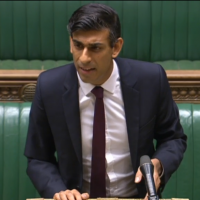
The PM’s pledge comes ahead of a speech by the housing secretary Michael Gove that will set out measures to achieve the government’s target such as regenerating disused brownfield land, streamlining planning process and helping homeowners to renovate and extend their houses outwards and upwards.
The government plans to focus on inner-city development where it says housing demand is highest but growth is being held back. The plans will include an urban quarter in Cambridge which will include “state of the art facilities with cutting-edge laboratories and green spaces”.
Sunak said: “Today I can confirm that we will meet our manifesto commitment to build one million homes over this parliament. That’s a beautiful new home for a million individual families in every corner of our country.
“We need to keep going because we want more people to realise the dream of owning their own home.
“We won’t do that by concreting over the countryside – our plan is to build the right homes where there is the most need and where there is local support, in the heart of Britain’s great cities.”
The government plans to take steps to unblock bottlenecks in the planning system that are slowing down development by:
- Immediately launching a £24m Planning Skills Delivery Fund to clear backlogs and get the right skills in place.
- Setting up a team of leading planners and other experts charged with working across the planning system to unblock major housing developments. The team will first be deployed in Cambridge.
- Developers will also be asked to contribute more through fees, to help support a higher quality more efficient planning service.
New flexibilities to convert shops, takeaways and betting shops into homes will help to rejuvenate the high street. Red tape will be cut to enable barn conversions and the repurposing of agricultural buildings and disused warehouses.
New freedoms to extend homes, convert lofts and renovate new buildings will help to convert existing properties into new accommodation.
A review into the extension of permitted development rights will make it easier for homeowners to build upwards and outwards – with new extensions and loft conversions – whilst ensuring neighbours’ interests are protected.
Oli Creasey, property research analyst at Quilter Cheviot, criticised the government’s policy announcements. “Unfortunately, like much of the housing policy that has come before, it is somewhat of a damp squib,” he said.
“In principle, it’s a sensible policy. The issue with the longstanding target to build 300,000 homes a year is that it is too blunt – in theory it’s relatively straightforward to build thousands of homes on an out-of-the-way brownfield site – far more difficult is developing the surrounding infrastructure (schools, jobs, shops,) that make people want to live there. Prioritising construction within existing urban centres alleviates this issue – the infrastructure is already there.
“However, urban construction isn’t easy either. Easing planning restrictions will help, but the land is more expensive, building costs are higher, and rezoning former retail sites, for example, as residential developments could tip the balance of homes versus amenities in the other direction. Part of current planning constraints does come from so-called “NIMBYism”, but it also reflects the desire of local councils to not hollow out their town centres with new apartments. Furthermore, planning departments are generally under-funded and struggling to work through existing backlogs. Michael Gove’s plan includes funds and personnel to tackle this backlog, but £24m is somewhat underwhelming.
“We will await further details on the proposals, but our initial view is that this is unlikely to have a significant impact on the number of planning approvals, or the number of homes built.”


















